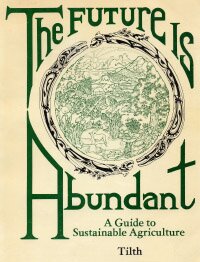
The Future is Abundant
A Guide to Sustainable Agriculture
Tilth Producers of Washington Home | WA Tilth Assoc. | Conference | Directory | Journal | Placement Service | Calendar | Action Alerts
Legislative Update | Bulletin Board | Classifieds | Questions on Agriculture? | Photo Gallery | Links | Contact Us | Join Now | Volunteer

Most plant species in temperate regions reproduce and evolve through their seeds. Wherever frosts occur, plants which bear seeds predominate over those which reproduce vegetatively.
During the 19th century, seed production was a local or regional activity. Some of the more skilled growers formed their own small companies and encourages neighbors to grow seed. Shaker communities in upstate New York and elsewhere saved seeds and made them available to each other, and commerical efforts prospered in Connecticut, Pennsylvania and Michigan. Eventually, plant diseases drove seed production to specialized areas such as parts of Oregon, Washington, Idaho, Arizona and California, where favorable climate and soil conditions make it possible to grow vast quantities of seed for worldwide distribution. In order to maintain hardy, locally adapted varieties, however, it is necessary to decentralize seed raising and to re-establish it in the home garden, where seed selection began centuries ago.
For the sake of a healthy and diverse agricultural future in our own region, we need seed foundations, seed exchanges and local seed banks. Every small valley, island and regional watershed contains valuable native plants and adapted cultivars. Individuals and groups would do well to inventory, collect and catalog the flora of their neighborhoods for the benefit of future generations.
Seed collectors, selectors and plant breeders develop plant species from plants most llike the ones wanted for cultivation in following seasons. Commercial food-plant breeders tend to select for earliness, hardiness, yield, taste and size, and flower growers for height, color, texture and duration of bloom. In other situations concern is with drought-hardiness, nutrient content, and insect- and disease-resistance.
Almost all of our primary food plants, cultivated herbs and flowers in the Pacific Northwest originated somewhere else. Because ill-adapted plants are difficult to maintain, finding or developing varieties of non-native plants which will naturalize can ease a gardener's labor. For this reason, gardeners will find their seed selection and saving efforts amply rewarded.
Some cultivated plants will persist for generations in the wild if their seeds fall disturbed ground such as unused marginal land, broken sod or a roadside embankment. In a home garden many plants will be able to reproduce by themselves, or self-sow, if allowed to go to seed. In one or two plant generations this naturalizing process becomes apparent as volunteers begin to compete more vigorously with the weeds than their immigrant parents did.
Seed collecting is best done during dry weather. Seed contained in a fruit may either be dried or fermented for a few days in the pulp to slough off the seed coats. Seed borne atop a flower stalk may be shaken when fully ripe into a container such as a breadpan or tight-woven basket, or the tops may be gathered and the seed rubbed out. The seed should then be winnowed by pouring between two containers in a light breeze. The wind will carry off the chaff and dust. For winnowing it is helpful to have a screen mounted on a wooden frame (#16 mesh is easiest to obtain).
Thorough cleaning is good protection against seed-borne pests and diseases. Stored seed must be very dry to discourage mold. Paper and cloth are adequate storage materials if humidity remains low. Glass helps protect against humidity and rodents.
Seeds metabolize in their resting state, gradually using up their carbohydrate reserves. With relatively constant environmental conditions, however, seeds will remain viable for a surprisingly long time. In some cases very old seeds which can still germinate produce superior plants.
The portion of the plant's life cycle spent in seed form might be considered a kind of sleep, in which the experiences of the preceding lifetime, including pollination and fertilization, are integrated in preparation for the next unfoldment. This time might also be considered meditation, where the life-force withdraws from the leaves and flowers to concentrate in the seed, or essence. The seed germinates and returns to plant form, with a slightly evolved consciousness that enables the species to survive in a changing world.
Tilth Producers of Washington Home | WA Tilth Assoc. | Conference | Directory | Journal | Placement Service | Calendar | Action Alerts
Legislative Update | Bulletin Board | Classifieds | Questions on Agriculture? | Photo Gallery | Links | Contact Us | Join Now | Volunteer